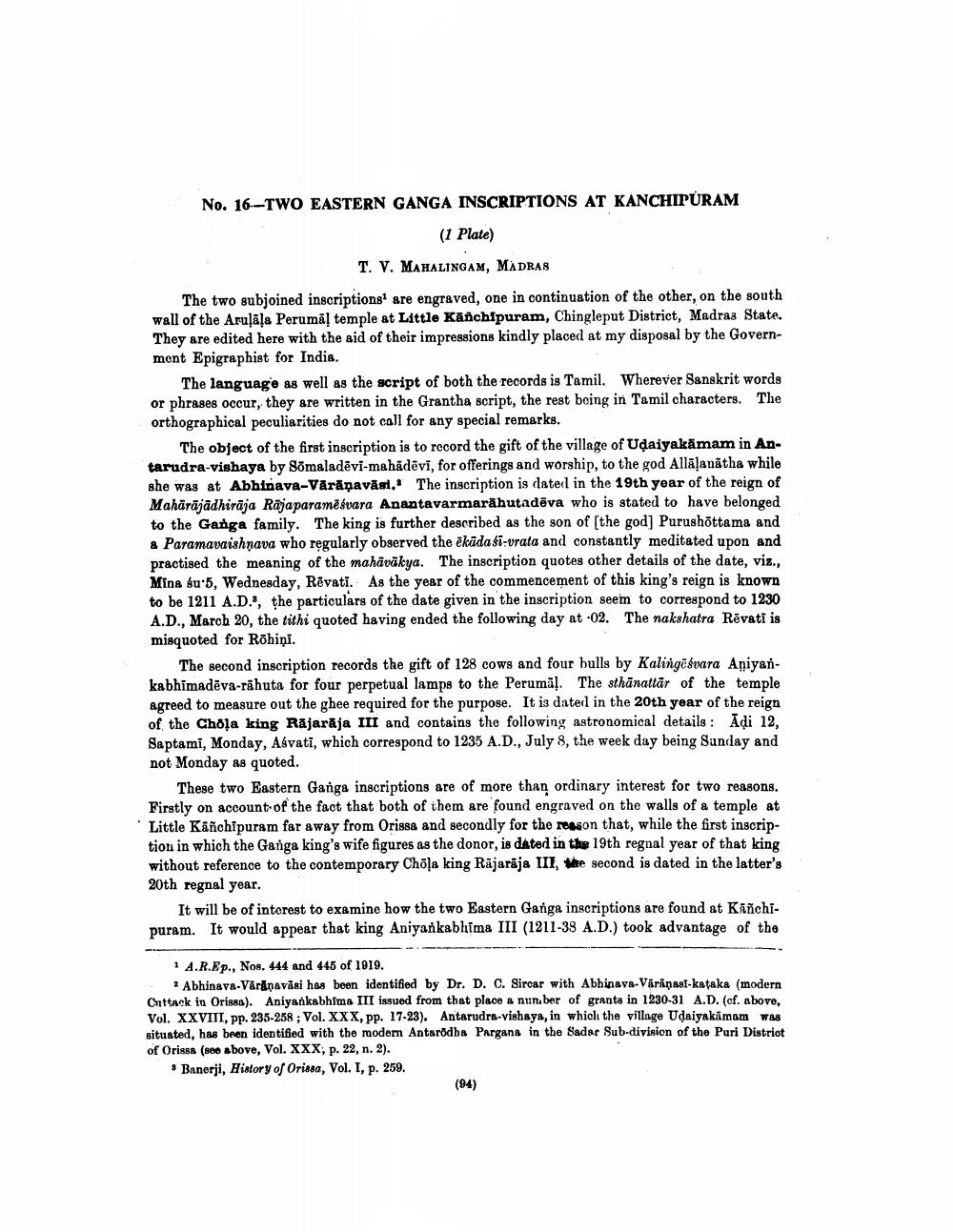________________
No. 16--TWO EASTERN GANGA INSCRIPTIONS AT KANCHIPURAM
(1 Plate)
T. V. MAHALINGAM, MADRAS The two subjoined inscriptions are engraved, one in continuation of the other, on the south wall of the Aruļāla Perumal temple at Little Kāñchipuram, Chingleput District, Madras State. They are edited here with the aid of their impressions kindly placed at my disposal by the Government Epigraphist for India.
The language as well as the script of both the records is Tamil. Wherever Sanskrit words or phrases occur, they are written in the Grantha script, the rest being in Tamil characters. The orthographical peculiarities do not call for any special remarks.
The object of the first inscription is to record the gift of the village of Udaiyakämam in Antarudra vishaya by Sömaladēvi-mahädēvi, for offerings and worship, to the god Allalanatha while she was at Abhinava-Vārāņavāsi. The inscription is datel in the 19th year of the reign of Mahārājādhirāja Rajaparamēsvara Anantavarmarāhutadēva who is stated to have belonged to the Ganga family. The king is further described as the son of the god] Purushottama and a Paramavaishnava who regularly observed the ekādaśī-vrata and constantly meditated upon and practised the meaning of the mahāvākya. The inscription quotes other details of the date, viz., Mina su 5, Wednesday, Rēvati. As the year of the commencement of this king's reign is known to be 1211 A.D.', the particulars of the date given in the inscription seem to correspond to 1230 A.D., March 20, the tithi quoted having ended the following day at 02. The nakshatra Rövati is misquoted for Röhini.
The second inscription records the gift of 128 cows and four bulls by Kalingesvara Aniyankabhimadēva-rähuta for four perpetual lamps to the Perumal. The sthānattar of the temple agreed to measure out the ghee required for the purpose. It is dated in the 20th year of the reign of the Chola king Rājarăja III and contains the following astronomical details : Adi 12, Saptami, Monday, Aśvati, which correspond to 1235 A.D., July 8, the week day being Sunday and not Monday As quoted.
These two Eastern Ganga inscriptions are of more than ordinary interest for two reasons. Firstly on account of the fact that both of them are found engraved on the walls of a temple at Little Kanchipuram far away from Orissa and secondly for the reason that, while the first inscription in which the Ganga king's wife figures as the donor, is dated in the 19th regnal year of that king without reference to the contemporary Chõļa king Rajaraja III, Whe second is dated in the latter's 20th regnal year.
It will be of interest to examine how the two Eastern Ganga inscriptions are found at Kanchipuram. It would appear that king Aniyankabhima III (1211-38 A.D.) took advantage of the
1 A.R.Ep., No. 444 and 445 of 1919.
· Abhinava-Varanavasi has been identified by Dr. D. C. Sircar with Abhinava-Varanasi-kataka (modern Cuttack in Orissa). Aniyankabhima III issued from that place a nunber of grants in 1230-31 A.D. (of. above, Vol. XXVIII, pp. 235-258 ; Vol. XXX, pp. 17-23). Antarudra-vishaya, in which the village Udaiyakamam was situated, has been identified with the modern Antarddha Pargana in the Sadar Sub-division of the Puri District of Orissa (see above, Vol. XXX, p. 22, n. 2). • Banerji, History of Orissa, Vol. I, p. 259.
(94)




